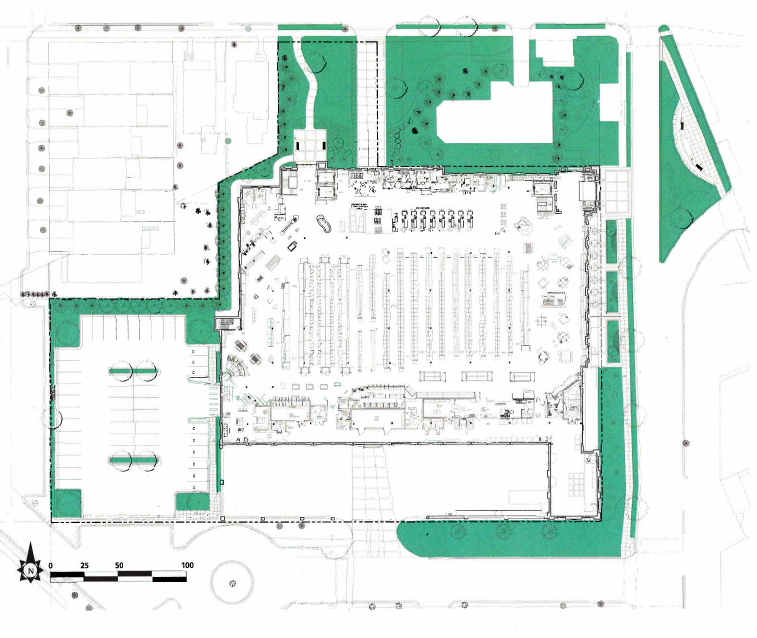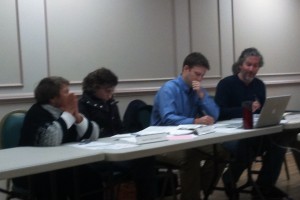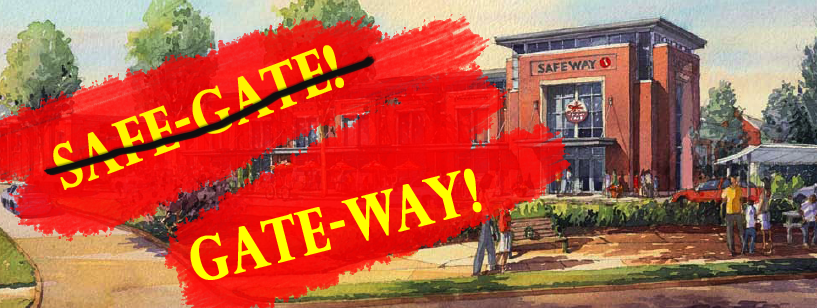I apologize for the delay, but here’s the Safeway portion of the ANC meeting. However, this should get everyone excited for December’s meeting, no?
Safeway sent Avis Black, the Regional Real Estate Manager for DC, as a representative instead of their pricklier spokesman. She reiterated Safeway’s position as wanting to work with the community and then stood for questions. And I mean stood there – she faced the audience for at least an hour of tempered but stern questioning. And for all the criticism, everyone was polite and cooperative. In fact, most of the other people who spoke brought up, again and again, that they wanted changes to the plan, not no growth at all. Actually, many present were conducive to a project that would build an as-of-right building above a store that was still larger than the existing one, but not so gargantuan as the proposed.
First to stand was Adam Rubinson, the de facto leader of the critics. He likewise reiterated his requests for Safeway to make substantial changes to the design of the new store. He listed off the general complaints everyone involved has heard so far, as well as some new ones. I’ll repeat them here for people who weren’t there.

The foremost concern (which most people mentioned) was the 40-foot wall that would currently end up 15 feet from the lots of ten houses that back Safeway’s property. Although the store is only 16 or so feet high, there is a vertical change of almost 30 feet from 42nd street to the west edge of Safeway’s parcel. Underneath the building sits a semi-underground lot. You can see in the rendering above that Torti Gallas attempted to break up the bulk of the building, but at 40’ it’s still massive, as you can see in comparison to the size of the house next door. Most of the other people who spoke covered at least one of these points, but with less patience and approachability than Rubinson had, and understandably so.

Other complaints were equally understandable. Residents decried the large suburban parking lot extending out of the back of the store. The noise and height of mechanical equipment raised concerns, as did the possibility of bright lights covering a pathway in rear of the building. Actually, that pathway is particularly problematic, because even with the planned row of shrubbery and fencing, residents expressed concerns over a lack of privacy. The pathway exists, in part, to allow GDS students to walk over to the entrance, which is sort of useful, since many eat lunch there.
Some complained about a lack of responsiveness, limited communication, and betrayal. The postcards were a subject of some spirited debate and question dodging. Repeatedly (Ms. Black was standing up front the whole time) residents called Safeway out on its claims of being a good neighbor. Between the infamous postcards and only limited changes to the plans since their submission in August, residents were frustrated. They all want to maintain certain aspects of Tenleytown, faulting Safeway for not sufficiently adapting their suburban schema to the architectural character of the neighborhood.
In essence, what most residents called for was better urban design to match the urban aesthetics Safeway had already applied to the project. The project, as currently designed, faces entirely inward. Although the building includes a Starbucks and a dry cleaner, they do no address 42nd street, but rather the interior of the store, and would be owned and operated by Safeway. That’s a quintessentially suburban configuration, easily found in Wal-Marts. So when the commission took the floor, they really drove at adapting the entire concept of the store to integrate as part of the city.

Beverley Sklover wanted to ensure that the project received LEED Gold certification, to which Ms. Black (erroneously) claimed to have reached Silver certification. Lucy Eldredge asked about what changes had been made since October’s Zoning Commission meeting. Meanwhile one-man tough room Sam Serebin’s understated bluntness drove home the dissatisfaction felt equally across the board. John Frumin challenged the use of the suburban model altogether and suggested Safeway start again with the design. Which nicely set the stage for John Bender, the chair and the representative responsible for the directly affected residents.
Bender brought up the Zoning Commission hearing, in which the members excoriated Safeway for producing a mediocre building with no real amenities, part of the exchange that characterizes a PUD. Without breaking, Bender and the other commissioners suggested a number of alternatives with more density than Safeway proposes. With the exception of a shout about more green space, the crowd was generally open to the possibility of a 3-4-story structure with perhaps some townhouses behind the structure. They asked for something truly urban instead. If Safeway did not fundamentally revise its plans by December, Bender, Rubinson, and others all warned that they would be much less cooperative.
ANC 3E next meets on December 10th at 7:30 PM in the Hall of Judgments (the basement of St. Mary’s Armenian Apostolic Church).
